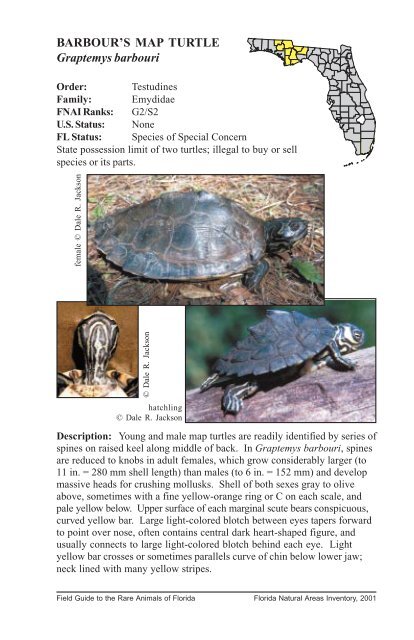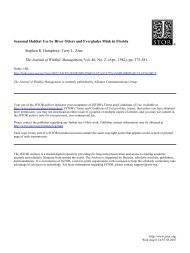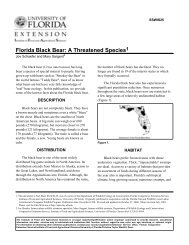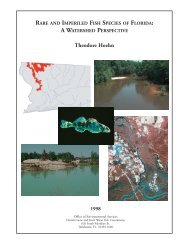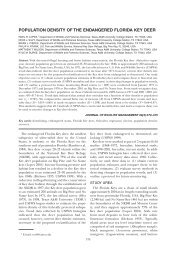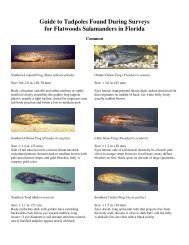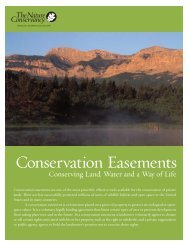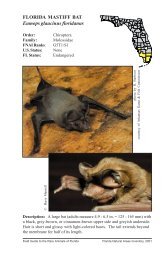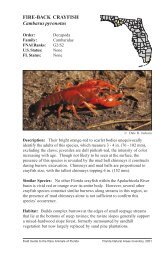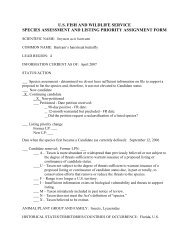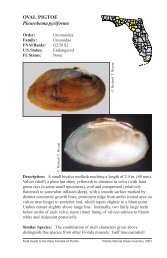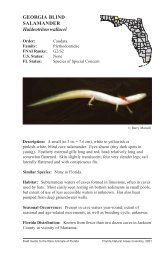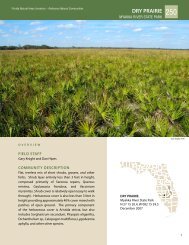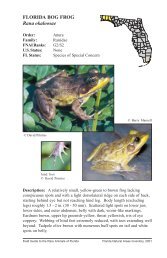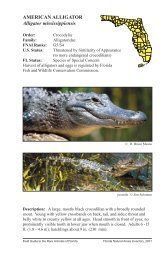BARBOUR'S MAP TURTLE Graptemys barbouri - Florida Wildlife ...
BARBOUR'S MAP TURTLE Graptemys barbouri - Florida Wildlife ...
BARBOUR'S MAP TURTLE Graptemys barbouri - Florida Wildlife ...
You also want an ePaper? Increase the reach of your titles
YUMPU automatically turns print PDFs into web optimized ePapers that Google loves.
BARBOUR’S <strong>MAP</strong> <strong>TURTLE</strong><strong>Graptemys</strong> <strong>barbouri</strong>Order: TestudinesFamily: EmydidaeFNAI Ranks: G2/S2U.S. Status: NoneFL Status: Species of Special ConcernState possession limit of two turtles; illegal to buy or sellspecies or its parts.© Dale R. Jacksonfemale © Dale R. Jacksonhatchling© Dale R. JacksonDescription: Young and male map turtles are readily identified by series ofspines on raised keel along middle of back. In <strong>Graptemys</strong> <strong>barbouri</strong>, spinesare reduced to knobs in adult females, which grow considerably larger (to11 in. = 280 mm shell length) than males (to 6 in. = 152 mm) and developmassive heads for crushing mollusks. Shell of both sexes gray to oliveabove, sometimes with a fine yellow-orange ring or C on each scale, andpale yellow below. Upper surface of each marginal scute bears conspicuous,curved yellow bar. Large light-colored blotch between eyes tapers forwardto point over nose, often contains central dark heart-shaped figure, andusually connects to large light-colored blotch behind each eye. Lightyellow bar crosses or sometimes parallels curve of chin below lower jaw;neck lined with many yellow stripes.Field Guide to the Rare Animals of <strong>Florida</strong> <strong>Florida</strong> Natural Areas Inventory, 2001
BARBOUR’S <strong>MAP</strong> <strong>TURTLE</strong><strong>Graptemys</strong> <strong>barbouri</strong>Similar Species: Barbour’s and Escambia map turtles (<strong>Graptemys</strong> ernsti;see species account) differ in fine details of color pattern on head andcarapace but remain difficult to distinguish; surest method is to baseidentification upon river of origin, as the two have non-overlapping ranges.The spines or knobs along backs of map turtles readily distinguish themfrom other non-hatchling freshwater turtles in <strong>Florida</strong>.Habitat: Rivers, large streams, and impoundments, usually favoring areaswith good flow and avoiding backwaters. Nesting occurs along sand bars,river berms, and spoil mounds.Seasonal Occurrence: Present year-round, but basking individuals aremore conspicuous from mid-spring through fall. Females nest from latespring to early summer.<strong>Florida</strong> Distribution: Though long thought restricted to ApalachicolaRiver system, including Chipola River, recent observations have confirmedthis turtle’s presence in Choctawhatchee and Ochlockonee rivers as well.Whether this is a result of human introduction is unknown, but fossilsdocument a past distribution that included Suwannee River system evenfarther away. Ranges downstream in Apalachicola to tidewater influence,well south of Forbes Island.Range-wide Distribution: Extends northward in Apalachicola Riversystem in both Chattahoochee and Flint rivers of Alabama and Georgia, andhas been recorded in southern Alabama in Pea River (Choctawhatcheedrainage).Conservation Status: Much of the Apalachicola River floodplain, and someof Choctawhatchee and Ochlockonee rivers, are public lands. However, waterquality of all three rivers is threatened by pollution, particularly from Georgiaand Alabama. Annual dredging of Apalachicola for barge traffic degradeshabitat both for turtles and for mussels and other animals upon which turtlefeeds.Protection and Management: Acquire additional floodplain andbordering uplands along all inhabited rivers. On Apalachicola River, enddredging and secure agreements with Georgia and Alabama to reducepollution and to maintain ample water flow.Selected References: Ashton and Ashton 1991, Bartlett and Bartlett 1999,Conant and Collins 1991, Ernst et al. 1994, Georgia DNR 1999, Moler (ed.)1992, Mount 1975.Field Guide to the Rare Animals of <strong>Florida</strong> <strong>Florida</strong> Natural Areas Inventory, 2001


